“What
is a stick but the sign of an aesthetic progress,
whereby
the prehistoric tree limb has been whittled down
to
a bludgeon, the bludgeon to a club, to a walking stick,
to
an ornamental cane?”
H.
G. Lang, Superintendent of Agency Police
Kathiawar,
India, 19221
Introduction
Like everybody else who studied martial arts in the 1970s, I was fascinated by Hatsumi and Chamber’s classic book, Stick Fighting. As a long-time student of Danzan Ryu Jujutsu, I have always liked jointlocking, and the use of the 3-foot stick (hanbo) or cane to apply these locks was even more interesting. So, in the late 1990s, I began a systematic study of jointlocks and takedowns with the stick and cane.
I collected techniques from more than 125 books, videos, DVDs, and CDs on the topic and drew from my own 35 years of martial arts training in jujutsu, iaido, aikido, Filipino Kali, and police arts. The techniques I collected: 1) specifically require a stick or cane to perform, 2) quickly become a joint lock, takedown, or unusual counterattack, and 3) are reasonably mechanically and combatively sound; that is, the interception, manipulation, and finishing movements are practical, effective, efficient, more or less difficult to counter, and form a coherent technique.
The
result of this 7-year effort is a book titled The Stick and Cane
in Close Combat: Jointlocks, Takedowns, and Surprise Attacks (301
pages; Unique Publications, 2006). The book presents nearly 120
jointlocks, takedowns, chokes, holds, disarms, unexpected strikes,
rolls, and exercises with the stick and cane in more than 750
photographs. These techniques are the largest and, I hope, the best
collection of its kind. Unfortunately, Unique Publications published
the book without my review or approval. As a result, it contains
several editorial errors and horrific design features that detract
from an otherwise sound presentation of the techniques. (Contact me
if you are considering working with this company!)
Uses of the Stick and Cane in Combat
As weapons, sticks and canes can be used for three basic styles of combat: fencing, striking, or grappling. Fencing with a stick requires the other guy to have a stick, too. Thus, today fencing with the stick is practiced more as a sport or an art form than as a fighting form simply because people with sticks are not nearly so likely to attack other people with sticks in daily life.
Striking with the stick—using it primarily as an impact weapon, especially against an unarmed or lightly armed opponent—is the most effective combative application of the stick or cane. Held in one hand, the stick becomes a long club; held in both hands, the stick becomes a riot baton or, less commonly, a sword-like weapon. Irrespective of how the stick is held, however, and with some exceptions, most strikes and targets are self-evident (although I teach 60 different strikes with the stick or cane).
Grappling
with the stick involves using the stick to apply joint locks,
takedowns, chokes, and pins. Thus, to the actions of striking and
thrusting found in the above styles of stick fighting are added the
actions of pressing (pulling or pushing the shaft into the opponent’s
body to attack or hold) and prying (leveraging the shaft against one
part of the opponent’s body to move another part). These
techniques are essentially “techniques of opportunity” that are
best applied when an opponent closes with you to get within the
effective striking range of the stick.
Sample Techniques
Of the 80 or so jointlocks and takedowns presented in the book, I describe here 5 representative techniques, 3 for the hanbo and 2 for the hook-handled cane.
The
scissor hold, in which you trap a body part against the shaft with
crossed forearms, is common in hanbo techniques. One of the more
unique applications is the Rear Shoulder Scissors Hold
(Figs.1.1 through 1.4). Here, you parry a punch to the inside with
your right hand and strike the opponent in the ribs with the stick in
your left. Placing the stick along side his neck from under his
right arm, you then reach back behind him with your right hand and
regrip the stick. This move crosses your arms and puts you behind
his right shoulder. To take him down, pull your arms to your chest
and step back until he drops to the ground. The hold effectively
controls his right arm. The pressure on his chest and sometimes his
collarbone is enough to obtain submission.
Bokendo
is an art within Danzan Ryu Jujutsu in which a heavy wooden
sword (heavier than the standard boken) is used much like a
riot baton. For the most part, bokendo techniques are
aggressive, direct, and devastating. One such technique is the Thumb
Press and Armlock (Figs.2.1 through 2.6). In this technique,
your opponent has gripped your right wrist from the side with his
right hand. Bringing the end of the hanbo over his wrist and
gripping the butt with your left hand allows you to trap his hand
against the shaft with your left thumb and right forearm. With this
leverage, you can apply a wrist lock that breaks his balance,
allowing you to turn to your left and to throw him over your right
leg, as in tai otoshi.
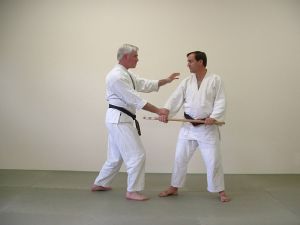
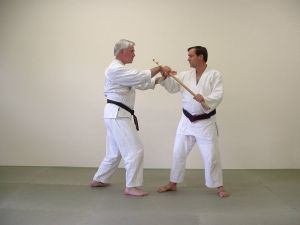
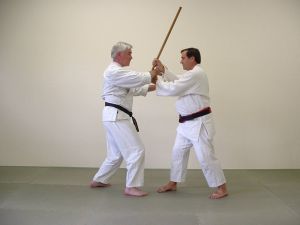
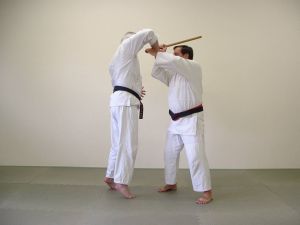
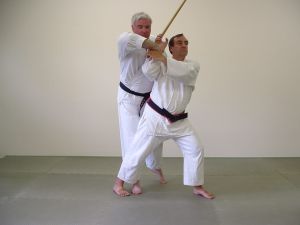
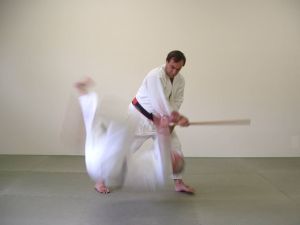
In
the Quick Choke (Figs. 3.1 through 3.4), you parry a punch
down with your left hand, strike the opponent in the neck with your
right, then roll the stick across his neck as you step beside him.
Reaching behind him with your left hand, you regrip the stick and
choke him by holding the other end of the stick against your own
neck. Controlling his right arm with yours and arching his back with
pressure on his throat sets him up for a rear throw.
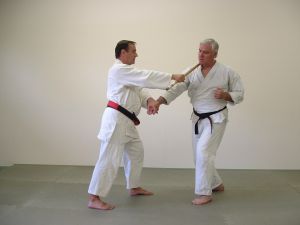
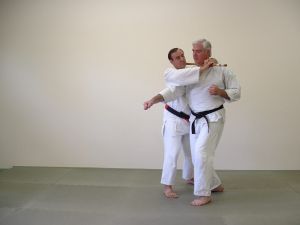
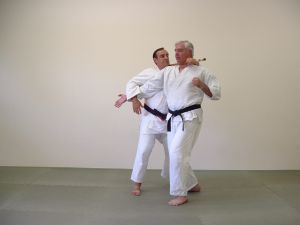
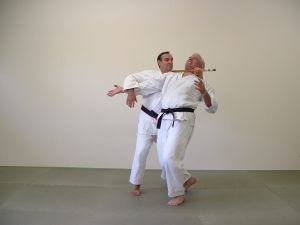
I found very few good grappling techniques for the cane; the hook is not nearly as useful as one might think. The Whirling Hammerlock is a technique I adapted from a side-handle police baton technique (Figs. 4.1 to 4.5). After doubling the opponent over with a thrust to the solar plexus, you insert the cane, handle up, under his left arm and hook his elbow. You then regrip the tip of the cane with your left hand and pull it forward and down to bend him forward with pressure on his shoulder. Keeping the pressure on, you turn to your left and drop, maintaining the hammerlock after he comes face-down to the ground.
One of the simplest techniques with either the hanbo or the cane is the Thigh-Poke Takedown (Figs. 5.1 through 5.3). Here, you block a punch to the outside, step on his right foot with your left, place the tip of the cane in the fold of his right thigh, and push him back and down to the ground. This technique is one of only two that can be applied with one hand.
Other
Topics Covered in the Book
The book is divided in to 4 parts, 16 chapters, and 3 appendices. Part 1, "Of Sticks and Canes" is an introduction and background to the rest of the book. Chapter 1 describes the physical characteristics of sticks and canes used in the techniques, and Chapter 2 reviews some of the more common traditions of stick and cane fighting and offers some thoughts on how to practice the techniques.
Part 2, "Stick Techniques," presents techniques that can be performed with either a stick about 3-feet long (specifically, the Japanese hanbo) or with any stout cane, with any type of handle. Chapter 3 describes the handling of the stick and defines the terms used throughout the book. Chapters 4 through 8 describe how the stick can be used against reaches, grips on the stick, grips on the body, punches, and kicks, respectively. Chapter 9 shows some techniques for disarming an opponent armed with a stick.
Part 3, "Cane Techniques," begins with Chapter 10, which describes the intended and combative use of the cane, types of canes, and basic terms, stances, and movements with the cane. Chapters 11 and 12 then present techniques specifically for the hook-handled cane held in the "in-line grip" (by the handle) and in the "carrying grip" (with the hook forward), respectively.
Part 4, “More Skills, Thoughts, and Information,” includes some other techniques with the stick and cane. Chapter 13 describes several front and back rolls with a stick or cane, and Chapter 14 presents some basic warm-up exercises with the stick. Chapter 15 shows some techniques that I term “less-reliable” because I found them to be largely unrealistic or ineffective, despite being commonly portrayed in books and videos. Finally, Chapter 16 is an extensive bibliography of books, videos, and DVDs on the topic of stick and cane fighting.
A
Note on “Less-Reliable” Techniques
In reviewing the books and videos on stick and cane fighting, I was surprised at how many techniques seemed to be either combatively unrealistic, mechanically weak, or both. The entrance into the technique might be contrived, the movements might be awkward or inefficient, or the assumptions about what the opponent did or did not do might be questionable. In some cases, a technique would appear to be spectacularly effective, but closer inspection would reveal that the opponent must have cooperated to make the technique work or that the stick was really not important to the technique at all. In others, the technique really could be effective, but only if modified in important and sometimes subtle ways that came to light only after experimenting with it. A large number of others were simply too absurd to consider.
As a result of this experience, I included a chapter on some techniques that I believe are unreliable or weak, despite that fact that they commonly appear in books and videos on the topic. My purpose is not to criticize the martial traditions that include these techniques but rather to focus attention on what makes a stronger technique by showing what—in my opinion—makes a weaker one. These weaker techniques may work, after a fashion, and most have some aspect of interest, even if the technique as a whole was not remarkable. At the very least, they represent attempts to apply the stick and cane in new ways and are thus valuable for what we can learn from them, even if the attempt was not successful.
A
Final Thought
The combative reality of stick fighting is that you are probably better off blocking and striking than trying to apply an inventive lock or a clever takedown. Thus, although many of the techniques in my book can result in seriously injury, their more important value is to help those who practice them to develop more fully in body, mind, and spirit; that is, to become better martial artists and better human beings.
Japanese coy, or gold fish, are said to become lethargic and ill if left in a pond without a few large stones to explore. I see the stick and cane as stones that create additional relationships for the martial artist to explore. I hope you will enjoy the exploration as much as I do.
About
the Author
Tom Lang holds a 4th-degree black belt in Danzan Ryu Jujutsu from the American Judo and Jujitsu Federation and a second-degree black belt in iaido from the All Japan Kendo Federation, although he studied Muso Shinden Ryu Iaido for more than 15 years with Sensei Don Zier, of Chico, California. His publications include The Jo: The Japanese Short Staff (with Don Zier), and Jujutsu: Techniques and Tactics (with Doug Musser). He lives in Davis, California, and can be contacted at tomlangcom@aol.com or 530-758-8716.
------------------------------
1 Lang HG. The “Walking Stick” Method of Self-Defence, by an Officer of the Indian Police. London: Athletic publications, Ltd., 1922. This book was reprinted in 2004 by Paladin Press of Boulder, Colorado.